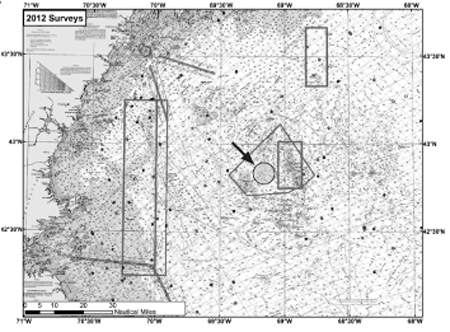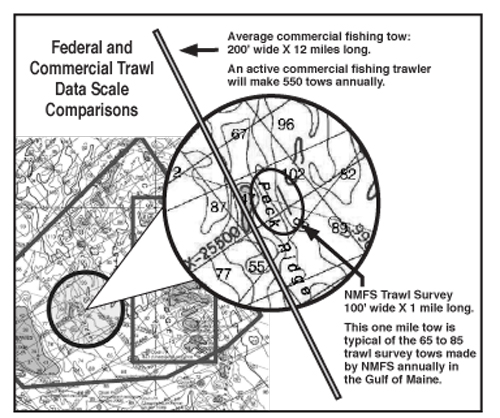Statistical Weakness of NMFS Groundfish Surveys Criticized
By Mike Crowe
This would not be
the case if the
assessment conclusions
were correct.
Gloucester ground fisherman and fishing industry advocate Vito Giacalone addressed what he described as the “statistical weakness” of National Marine Fisheries Service (NMFS) trawl survey data for inter-annual relative abundance changes for Gulf of Maine cod and other groundfish stocks.
Giacalone said the departure from using commercial catch per unit of effort (CPUE) data and and too great a reliance on the sparse stock sampling of the Northeast Fishery Science Center’s (NEFSC) annual trawl surveys that is driving the “disastrous” reductions in what fishermen are allowed to catch.
Giacalone, a 35-year veteran of the Gloucester, Mass., groundfish fleet and executive director of the Gloucester Fishing Community Preservation Fund, said there is a disconnect between computer model driven assessment conclusions and fishery-dependent data. “There is no plausible explanation for the disparity between what the assessment says about the cod stocks and what fishermen see on the water,” he said. The composition of different market class sizes in the landings remains stable. This, Giacalone said, would not be the case if the assessment conclusions were correct.

CHART A: Rectangles and the triangle mark areas closed to commercial fishing. Small squares indicate to scale NMFS one mile long Trawl Survey tows. They appear as squares to be visible at this scale. Commercial fishing vessel trawler tows range from 2-1/2 hours to 6 hours and are from 150 ft to 300 ft wide. The area in the circle with the arrow above is enlarged below, Chart B. Data on these charts is provided by Gloucester Fishing Community Preservation Fund.

CHART B: The enlargement of a NMFS Trawl Survey tow – line within oval above. The scale and volume from this 100' x one mile NMFS Trawl Survey tow is compared to an average commercial vessel tow – 4-hour commercial tow would be 200' x 12 miles long. The thickness of the lines describing the tow widths are not to scale. The lengths are to scale. An active commercial trawler would make more than 550 trawler tows a year compared to the NMFS annual 65 to 85 GOM Trawl Survey tows.
Further compounding the already contentious relationship was the highly criticized decision by the NEFSC to use Gulf of Maine Cod as a test subject for expediting updated assessments. Responding to calls for shortening the time to produce more timely assessments, the NEFSC conducted an experimental assessment process.
Traditionally, the assessment process involved an open discussion of the data to be run through computer models. The planned assessment would be announced. A formal peer review would be scheduled, which could be many months in the future, with peer reviewers typically being third-party scientists from around the world.
However, the experimental assessment, conducted by the NEFSC in Woods Hole, Mass., “was unscheduled, unannounced and not transparent,” said Giacalone.
News of the experimental assessment spun out of control and the results were almost immediately broadcast as gospel, said Giacalone, with the mainstream press broadcasting NMFS’s soundbite that GOM cod was at 3 percent of its “normal” stock level.
At that point, said Giacalone, there was no getting the genie back in the bottle.
Giacalone said the amount of data gained from NMFS trawl surveys is low compared to the volume of fisheries-based data.
“We are not debating quality,” he said. We’re stressing the statistical weakness of the survey and hoping to reopen the discussion around looking at existing commercial data to find comparative measures. “Compared to the NMFS trawl survey boat, commercial boats generate much more data. The question is, how do we utilize this enormous database that is currently being dismissed for this purpose? Can’t the commercial data be compared to the trawl survey data?”
